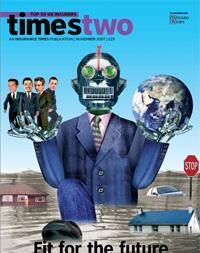Heard the one about the mortuary worker who sued his employer because he suddenly developed a fear of death? Or the postman who sued a lecturer for posting too many letters? Sarah Kennedy reports on the new claims insurers are having to consider
Question: What do nanotechnology, construction materials, climate change and stress all have in common?
Answer: They all stand to hit the wallets of insurance companies or at the very least, cause a lot of headaches.
Risk has always been an essential component to insurance. Without risk, insurers would be out of a job. But each generation has unfolded its own challenges to keep the industry comfortably employed.
Although it’s hard to argue that there are more risks today than in the past, most insurers would agree the emerging challenges are becoming increasingly complex.
Andrew Miller, manager of risk control surveyors at Allianz, says that as society becomes more litigious and consumers more aware of the legal options available, insurers stand to pay out more claims.
Business owners are also more concerned about the responsibilities they have to their employees and the risks they face if those responsibilities aren’t met. Recent history has seen a series of rare lawsuits that would cause concern for any insurer.
One only has to consider the case of a mortuary worker who sued his employer because he suddenly developed a fear of death. Or a lecturer who was sued by a postman for posting too many letters, points out liability expert Philip Bell of Royal & SunAlliance.
“People are constantly pushing at the edges of how far the law will allow them to go. People have higher expectations and they are suing now more than ever before,” he says.
The emergence of technology and the move towards a more digitalized society has led to risks the insurance industry hadn’t previously considered.
Whereas 20 years ago thefts of cigarettes, alcohol and clothing were the criminal norm, today financial and cyber crime have skyrocketed with the emergence of fraudulent credit and debit cards, used to fund a plethora of other scams, according to Allianz’s Miller.
He says: “We now need to be more aware and match the level of protection with the degree of risk. Insurers are not good at telling the future –we’re much more reactive. Risk management is much more challenging now and people are more demanding because they are much more informed.”
Growing concerns with climate change, exacerbated by the devastating summer floods, could lead to a round of the blame game but it’s a matter of where to point the finger.
The EU’s Environmental Liability Directive could have a significant impact on insurers as it gives the environment a legal status, said Bell.
Under the Environmental Liability Directive, the burden of proof may change, possibly prompting class-action lawsuits against companies accused of causing pollution or climate damage. In such circumstances, it would be up to them to prove their innocence.
Most in the industry will agree however, that with risk comes opportunity for both insurers and brokers alike. The responsibility lies with those inside the industry to stay informed of risks and mitigate damages.
BOX:
• Legal liabilities and stress – Ten years ago you would have been hard pressed to find mainstream thought linking stress and illness, but this has become a reality for employers and insurers as stress-related lawsuits have started to emerge. Andrew Miller, manager of risk control surveyors at Allianz, says stress may become one of the most costly risks for insurers as managers fail to recognize the signs of stress and affected employees seek compensation.
• Modern methods of construction -- As demand for homes and buildings soars under tight time pressures, the construction industry has moved towards using modern light weight building methods, prefabricated in factories. Far from the resilient bricks and stone buildings of the past, modern materials tend to be more flammable and less resilient to flooding. Insurers warn that increased incidences of fire in buildings constructed through modern methods will be a growing concern for the industry.
* Nanotechnology— This small but mighty technology is a new industrial procedure for building structures a few millionths of a millimetre in size. The technology has been touted as having the potential to revolutionize the detection and treatment of certain medical conditions along with the ability to increase durability of materials to withstand weather-related disasters. It has also been flagged as a potential headache for insurers with huge claims possibilities if the technology turns out in any way to be harmful. So far there is no scientific evidence to prove nanotechnology has had any negative impact on the health of users – however, the government has called for more research to be conducted.
• Cyber-crime – Every successful technological system will interest criminals and if they can use it to make money, they will, warn liability experts. Criminals are finding ways to commit online frauds, to obtain PIN and chip information and then use the information to develop fraudulent credit and debit cards. As technology expands, so do opportunities for crime.
• Climate change – Most insurers will admit that climate is changing and that we are likely to see more extremes in weather and increased frequency of flooding. The questions for insurers will be, if and when claims start to increase, who is to blame and how do you prove it? Insurers have long acknowledged that climate change will be an ongoing and diverse risk and many reports have been commissioned that show learning to manage or reduce these risks will be of the utmost importance. As the laws regarding climate change mature, companies could also be faced with increased lawsuits over pollution and waste management.


































